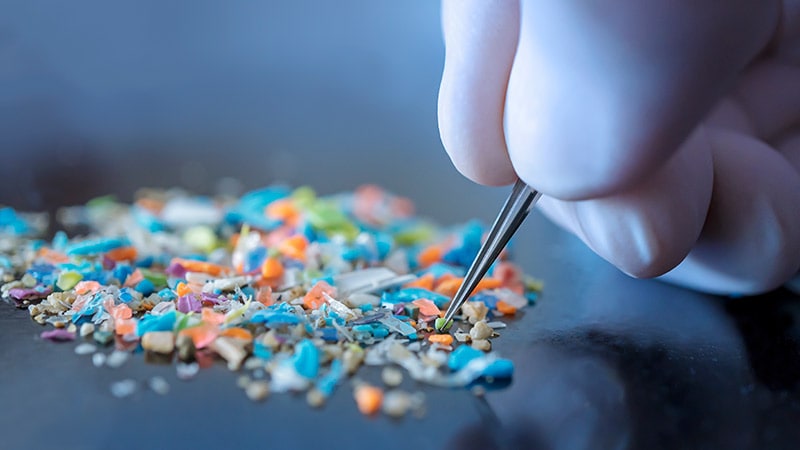The Potential Health Risks Posed by Microplastics: Exploring the Emerging Evidence
Core Concepts
Microplastics are a growing environmental concern, with the potential to pose significant risks to human health through various exposure routes, including ingestion and inhalation.
Abstract
The content discusses the increasing production and prevalence of microplastics (MPs) and nanoplastics (NPs) in the environment, and their potential health implications. Key points:
Plastic production has increased exponentially, from 2 million tons in 1950 to 460 million tons in 2019, with projections to triple by 2060.
Plastics contain over 10,000 chemicals, including carcinogenic substances and endocrine disruptors, leading to widespread environmental pollution.
Microplastics and nanoplastics are found in aquatic environments, terrestrial environments, and even in remote locations like the Eastern Alps.
Microplastics have been identified in hundreds of marine species, including those consumed by humans.
Humans can be exposed to microplastics through ingestion (e.g., from food and water stored in plastic containers) and inhalation.
Infants are particularly vulnerable, with high exposure levels from artificial milk preparation in polypropylene baby bottles.
Microplastics have been linked to potential health risks, such as cardiovascular diseases, inflammatory bowel disease, and other effects on glucose metabolism, reproduction, oxidative stress, and lipid metabolism.
However, the causal relationship between microplastics and disease is not yet fully understood, and the mechanisms by which they may influence cellular functions and induce stress responses require further investigation.
Future research will focus on quantifying the accumulation of microplastics in human tissues over a lifetime and understanding how their characteristics (e.g., chemical composition, size, shape) can influence organs and tissues.
What Health Risks Do Microplastics Pose?
Stats
Plastic production has increased from 2 million tons in 1950 to 460 million tons in 2019, and is expected to triple by 2060.
Microplastics and nanoplastics have been detected at a concentration of approximately 2.4 ± 1.3 × 10^5 particles per liter of bottled water, with around 90% being nanoplastics.
Infants can be exposed to microplastics at levels ranging from 14,600 to 4,550,000 particles per capita per day from artificial milk preparation in polypropylene baby bottles.
In 58.4% of cases, polyvinyl chloride was detected in the carotid artery plaque, with an average level of 5.2 ± 2.4 μg/mg of plaque.
Patients with microplastics inside the atheroma had a higher risk (relative risk, 4.53) for a composite cardiovascular event of myocardial infarction, stroke, or death from any cause at 34 months of follow-up.
Quotes
"Plastic pollution is one of the great environmental challenges of the 21st century, causing wide-ranging damage to ecosystems and human health."
"The way MNPs can cause harm, including through effects on the immune system and microbiome, will need to be clarified by investigating possible direct cytotoxic effects."
Key Insights Distilled From
by Paolo Sprian... at www.medscape.com 05-17-2024
https://www.medscape.com/viewarticle/what-health-risks-do-microplastics-pose-2024a10009f3
Deeper Inquiries
How can the potential health risks of microplastics be effectively mitigated through policy and regulatory measures?
To effectively mitigate the potential health risks of microplastics, robust policy and regulatory measures need to be implemented. Firstly, there should be strict regulations on plastic production, usage, and disposal to reduce the overall plastic pollution in the environment. This can include bans on single-use plastics, promoting eco-friendly alternatives, and implementing extended producer responsibility (EPR) programs to hold manufacturers accountable for the entire lifecycle of their products. Additionally, monitoring and surveillance systems should be established to track the levels of microplastics in various environments and assess their impact on human health. Public awareness campaigns can also play a crucial role in educating individuals about the risks associated with microplastics and encouraging sustainable consumption practices.
What are the potential long-term consequences of microplastic accumulation in the human body, and how can longitudinal studies help elucidate these effects?
The potential long-term consequences of microplastic accumulation in the human body are concerning and can include various health issues such as inflammation, oxidative stress, metabolic disorders, and cardiovascular diseases. Longitudinal studies, which track individuals over an extended period, can provide valuable insights into the effects of microplastics on human health. By analyzing the accumulation patterns, distribution, and interactions of microplastics within the body over time, researchers can better understand the mechanisms through which these particles may cause harm. Longitudinal studies can also help identify potential biomarkers of exposure and effects, allowing for early detection and intervention strategies to mitigate the long-term consequences of microplastic exposure.
Given the ubiquity of microplastics in the environment, what innovative solutions or technological advancements could be developed to address this global challenge?
Innovative solutions and technological advancements are essential to address the global challenge of microplastic pollution. One promising approach is the development of advanced filtration systems that can effectively capture and remove microplastics from water sources before they enter the ecosystem. Nanotechnology-based solutions, such as nanomaterials that can selectively bind to microplastics, show potential for efficient removal. Biodegradable polymers and materials that break down into non-toxic byproducts could also help reduce the accumulation of microplastics in the environment. Furthermore, the use of artificial intelligence (AI) and machine learning algorithms can enhance the detection and monitoring of microplastics in various environmental samples, enabling more targeted and effective mitigation strategies. Collaboration between scientists, policymakers, industry stakeholders, and the public is crucial to drive innovation and implement sustainable solutions to combat microplastic pollution.
0
